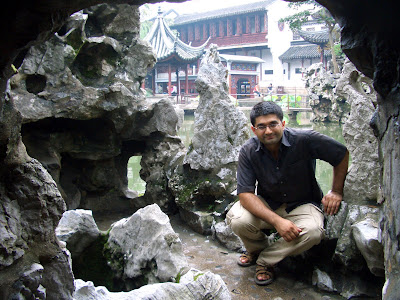Hangzhou is very close to Shanghai – only just over an hour away by the lovely comfy bullet train. It’s meant to be one of the most scenic places in China, but our first impression of the place wasn’t actually that great. Mainly because practically every downtown road there is being dug up – including the one outside the Railway Station (so navigation was interesting as there weren’t any road signs) and the street of our hotel (so we had to jump over a deep muddy moat to get to the door). But after we got out of the roadworks it was actually really nice, and well worth going to.
The town is built on the side of an incredibly scenic lake. It reminded us a bit of Udaipur in India – lovely water, hills in the background, but no silly palaces unfortunately. What it did have instead was gardens. Actually you could say the entire 3km long lake was surrounded by one massive garden. Very, very pretty, especially as the entire complex was beautifully maintained and stunningly intricate. We walked a circuit around the shores, and across its two long, garden filled causeways – approximately 14km in total! Luckily there were wonderful pagodas and pavilions every now and then which gave lovely views across the lake which were good for a scenic break.
The only real downside was the weather (again). After we arrived and dashed to the hotel there was a truly spectacular thunderstorm, which we missed getting drenched in by the skin of our teeth! Later it cleared up beautifully, so we went for a stroll by the side of the lake at sunset and saw another silly musical lighted fountain show (this one very cleverly and convincingly mimicked waves and opening flowers to some very cheesy Chinese Pop numbers). Unfortunately the next day was overcast, and the heavens decided to open completely halfway around our 14km lake circuit. We got home slightly damp…
Anyway, it was worth the sogginess for a truly lovely walk.



































